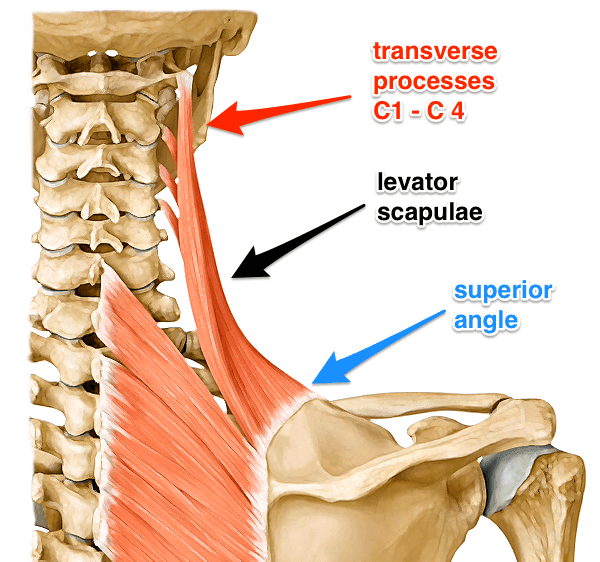The Levator scapulae is last of the muscles that move the scapula that we’ll look at in the ‘Muscle of the Month’ posts. So far we have covered the: rhomboids, trapezius, pectoralis minor, serratus anterior.
What does Levator scapulae mean?
Levator comes from the Latin word “levare” meaning “to lift”.
“Scapulae” refers to the scapula bone itself.
Therefore this is a muscle that lifts or elevates the scapula.
The levator scapulae, along with the rhomboids, forms the deep layer of muscles on the back.
Where does the Levator scapulae attach?
Levator scapula runs along the lateral posterior sides of the neck.
The inferior portion is normally deep to and covered by the trapezius.
The top or superior portion becomes superficial.
ORIGIN OF LEVATOR SCAPULAE
Levator scapula originates on the transverse processes of the vertebrae C1-C4.
INSERTION OF LEVATOR SCAPULAE
Levator scapulae inserts on the superior angle of the scapula.
What actions does the Levator scapulae do?
Because of the its location above the scapula, the primary action of Levator is elevation.
Due to the location of the Levator muscle and the ability of the scapula to rotate, when the Levator contracts it causes the scapula to do downward rotation.
If the scapula is stabilized and our body is in the right position, Levator scapulae can also assist in lateral flexion and extension of the head and neck.
What are the most common injuries to the Levator muscle?
The most common injury to the Levator scapulae is referred to as ‘Levator scapulae symdrome’. It is typically caused by overuse of Levator either from sports or from repetitive motion during daily activities.
Symptoms of Levator scapulae syndrome include:
- Pain, inflammation, and potentially restricted movement of neck.
Consult your physician for assessment and treatment recommendations.
Postures where the Levator scapulae muscle contracts:

LEVATOR CONTRACTS IN POSTURES WHERE WE DOWNWARDLY ROTATE OUR SCAPULA SUCH AS IN BINDINGS LIKE MARICHYASANA C AND OTHER POSTURES WHERE WE REACH OUR ARM BEHIND OUR BACK.

IN SHALABASANA THE LEVATOR WILL ASSIST IN HOLDING THE HEAD UP OR WHAT WE JUST REFERRED TO AS EXTENSION OF THE HEAD AND NECK.
Postures where the Levator scapulae muscle is lengthened:

WE MIGHT FIND THE LEVATOR LENGTHENING IN OUR HEADSTAND BECAUSE WE UPWARDLY ROTATING OUR SCAPULA AS WELL AS DEPRESSING THEM.
Additional Images

FROM TRIGGERPOINTS.NET



Комментариев нет:
Отправить комментарий